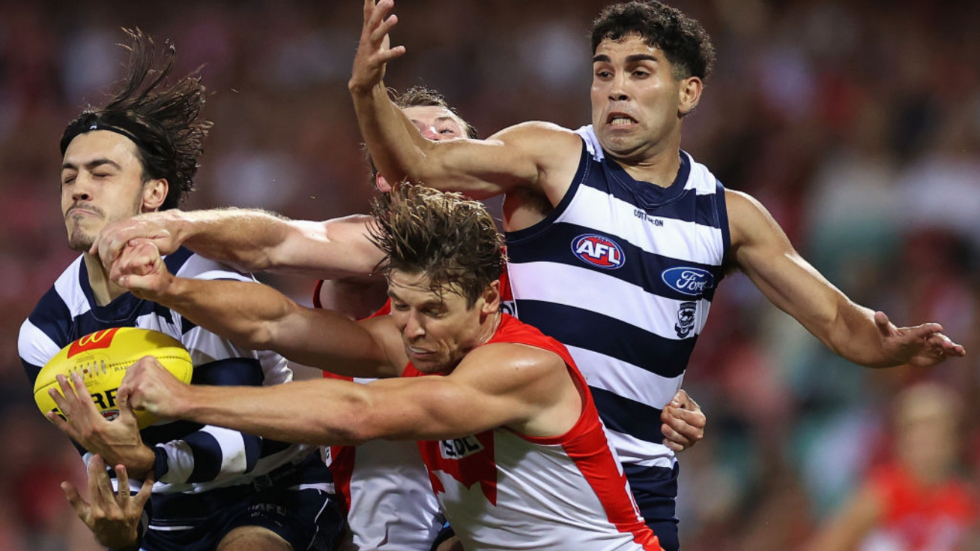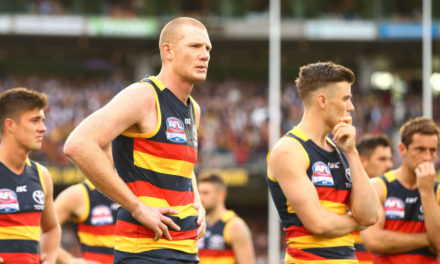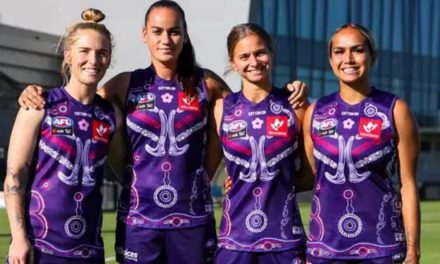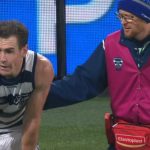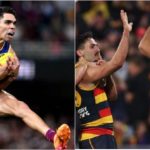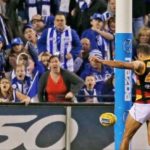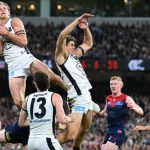Geelong’s Brad Close marks ahead of Sydney’s Dane Rampe in the Swans’ Round 2 win over the Cats. Photo: GETTY IMAGES
The first AFL grand final at the home of football in three years is also the first since 2007 that won’t feature a Melbourne-based club.
But neither Geelong nor Sydney have been short of support in and around the MCG this week; nor will they be when the red Sherrin is bounced in front of about 100,000 fans in the traditional Saturday afternoon time slot.
Based on form this century – an era in which both clubs have defied restrictive equalisation measures and the cyclical nature of the AFL – this is the grand final match-up that seemed bound to happen.
Storylines are abundant and there is no shortage of parallels between the two most consistent sides of the last two decades, who have rebuilt on the run to keep themselves in premiership contention more often than not.
But there has been a contrast at the selection table, where one side is unchanged and the other has swung a big surprise after a tough week for players racing against the clock to prove their fitness.
SELECTION
Struck down by a hamstring issue and substituted out of the preliminary final, Max Holmes was named by Geelong in an unchanged 22. But he faces another fitness test on Friday and the obvious proviso is the Cats have developed a reputation as kings of the late change. They will likely use every available minute before making a call on the young wingman, whose devastation last Friday night turned to hope by the start of grand final week and could develop into tears of joy by about 5pm on Saturday if he is selected and Geelong gets up. Irish midfielder Mark O’Connor looms as the most likely replacement for Holmes, having been the medical substitute last week. Brandan Parfitt and Sam Menegola were also named as emergencies and are capable of filling a similar role. Back-up ruckman Jon Ceglar is also in the 26-man squad. Sydney tall Sam Reid was substituted out of the preliminary final with an adductor injury and was restricted at training all week, as far as the cameras could tell. Regardless, he was named in the Swans’ 22. The big shock was Sydney dropping young tall Logan McDonald for Hayden McLean, who has not played an AFL game since round eight. McDonald has played 17 games this year but has managed just one goal from 10 disposals in two finals appearances. McLean’s versatility as a second ruck option behind Tom Hickey will allow Reid to play predominantly in attack next to Lance Franklin. Justin McInerney was named for Sydney despite concerns over an ankle injury that kept him on light duties during the week.
NEAR MISSES
Geelong and Sydney have given themselves every chance to be successful. The Cats have played 17 of the last 19 finals series; the Swans 17 of the last 20. Yet it’s been a decade since either won a flag. Geelong saluted in 2011; Sydney in 2012. Since their most recent premierships, the clubs have combined for six losing preliminary finals and three grand final defeats. Despite silverware eluding them, the records of venturing deep into September are something of which both clubs are proud. Their theory is simple, though not easy to execute: set your players up to have a crack at a premiership every year. “It might not work and you might be disappointed,” Cats coach Chris Scott said. “You’ve got to take that emotional risk, but we’re going to have a go.” Swans counterpart John Longmire agrees. “That’s our role as the footy department, to give the players a crack at the finals every year and give your supporters some hope,” he said. Those venturing to the MCG on Saturday should be thankful for it as fans of 16 rival clubs look on enviously.
THE SUPERSTARS
Chris Scott insists he doesn’t know who his team’s so-called “superstars” are. Indeed, there were five Cats named in the All-Australian team this year and more who have donned the green blazer before. But no name on the Geelong team sheet attracts the spotlight quite like Patrick Dangerfield. He and Sydney goal-kicking legend Lance Franklin are both chasing the “legacy piece” as they seek to cap their remarkable careers with a premiership. Franklin, of course, won two flags with Hawthorn before heading north. It’s easy to mount an argument that the 35-year-old’s mammoth nine-year, $10 million contract has already been a success for both player and club. The current Swans hierarchy would argue he’s put more bums on seats than Tony Lockett. Yet some critics remain. A Sydney flag in the final year of Franklin’s initial contract would end the debate once and for all. If not, he’ll get one last shot next year after boldly announcing “one more” this week. Dangerfield made a similar switch when he left Adelaide to return home at the end of 2015. The explosive midfielder’s first season at the Cats ended with a preliminary final defeat, and there have been another three losses in the penultimate week of the season since then. There was also the 2020 grand final, when Dustin Martin blew Geelong off the Gabba after half-time. But Dangerfield was the destroyer in last week’s thumping of Brisbane and enters grand final week in better condition than he has been in four years, according to his coach. Another monster game from Dangerfield could see Geelong over the line, but we all know Franklin loves the big stage as much as anyone.
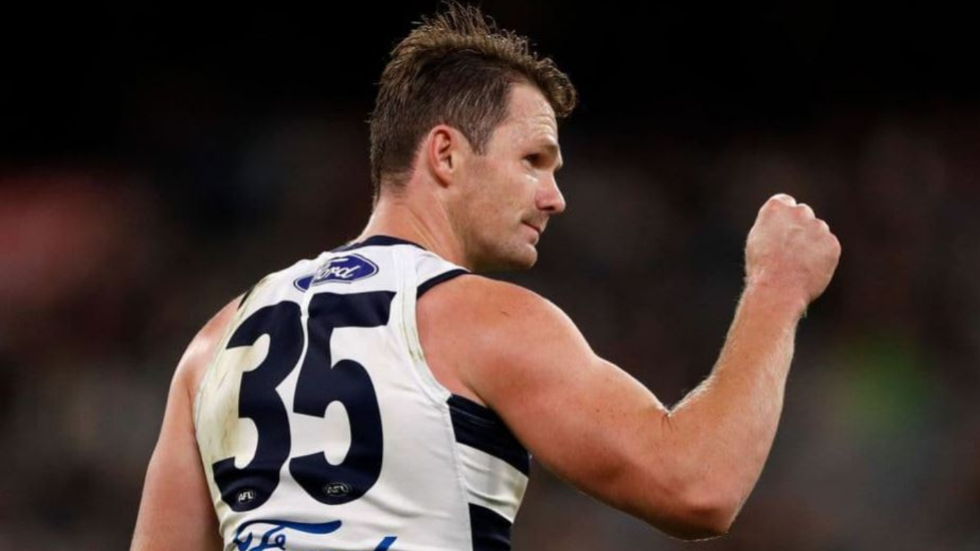
THE COMEBACK STORIES
Paddy McCartin retired because of repeated concussion issues and Tyson Stengle was cut loose by Adelaide after one too many off-field incidents. They’re two entirely different stories but both remarkable in their own way. The No.1 pick at the 2014 draft, McCartin was selected as a key forward but never reached his potential, largely due to those unfortunate setbacks. He retired at the end of 2019 but earned a rookie-list spot with the Swans this season after a year in their VFL side and will now line up in a grand final alongside brother Tom in defence. McCartin missed round seven under concussion protocols – and appeared shattered after being subbed out of an Anzac Day clash because of a head knock – but returned the following week and has played all but one game for the Swans this season. The 26-year-old has been a revelation in the back half. Stengle’s story isn’t just a comeback, it’s one of redemption. Multiple off-field indiscretions saw him banished by Adelaide prior to the 2021 season, but he excelled back at original club Woodville-West Torrens in the SANFL and earned a career lifeline with Geelong, due in part to ties with Cats football staff Eddie Betts and Shaun Grigg. This year, he was named alongside teammates Tom Hawkins and Jeremy Cameron in the All-Australian forward line, having kicked 46 goals in 22 home-and-away games in a breakout season. He was the competition’s second-most prolific small forward behind fellow Indigenous star (and former Crow) Charlie Cameron.
PLEASE HELP US CONTINUE TO THRIVE BY BECOMING AN OFFICIAL FOOTYOLOGY PATRON. JUST CLICK THIS LINK.
THE X-FACTORS
Joel Selwood and Chris Scott believe Jeremy Cameron is the competition’s most valuable player. The athletic spearhead may well frank that claim by snaring a best-and-fairest award in the premiership team. But there is plenty of water to go under the bridge yet. Nevertheless, if Geelong is to salute on Saturday, it will likely need a telling contribution from the former GWS spearhead, who has put hamstring setbacks behind him to kick 63 goals in 23 games this season. It’s not only direct scoreboard contributions where Cameron can kill you, but with his elite field kicking and ability to get up the ground crucial in setting up teammates. Franklin is Sydney’s obvious “X-factor” type, but Tom Papley is the real energiser bunny. If he gets a sniff around the goal, he’ll punish you. And he’ll celebrate as well, which fires up his teammates. Papley’s three goals and forward line craft in last week’s preliminary final were crucial in ensuring the Swans’ held on against fast-finishing Collingwood.

THE VETERANS
Only three Cats remain from the 2011 premiership. Joel Selwood, Tom Hawkins and Mitch Duncan have all lasted the distance. Despite all being well into the twilight of their careers – and among 10 Cats set to play in the grand final who are on the “wrong side” of 30 – all have been key figures in Geelong’s success this year. Hawkins was named All-Australian captain, Duncan has added versatility to his already impressive game and Selwood remains that rugged leader more likely than most to be forced off the field with a cut head. Already the competition’s longest serving captain, Selwood will surpass Michael Tuck’s record for finals appearances in the grand final. It will be his 40th final of a decorated career, which includes three premierships. Most players who enter the AFL system don’t play that many games in their careers. Sydney’s only remaining representatives from the 2012 premiership side are Sam Reid and Luke Parker. The latter played all three finals that season, his second at AFL level, but started all of them in the infamous green jacket (better than ending it in the red) and totalled just eight disposals in September. Reid kicked one goal from 13 disposals in the premiership victory over Hawthorn and needs to have a big impact against Geelong despite his injury concerns. It will be a tough week for Swans great Josh Kennedy, whose unlikely bid to return for the finals was ended by another hamstring injury. While the 34-year-old was an unused substitute in round 20, his final on-field appearance in an AFL match was in round 10. Kennedy has been a key driver behind the scenes, effectively as another assistant coach, imparting wisdom from his 290 games over 15 seasons, including the 2012 flag and subsequent grand final appearances in 2014 and 2016.
LIST BUILDS
As mentioned, both clubs have been willing to have a crack at rebuilding on the run in order to remain in premiership contention. It has involved moving heaven and earth to secure high-profile recruits – Patrick Dangerfield, Jeremy Cameron (both Geelong) and Lance Franklin (Sydney) as the prime examples – and making some more shrewd calls in the player movement markets. Isaac Smith, Zach Tuohy, Gary Rohan and Rhys Stanley have all joined Geelong from rival clubs and the Swans have brought in the likes of Tom Hickey, Ryan Clarke and Paddy McCartin. Both clubs are keen on locals, with the Swans making the most of their academy by jagging Errol Gulden, Braeden Campbell and Nick Blakey, while the Cats target a host of players from the greater Geelong area and country Victoria. The Cats took punts on Tom Stewart, Tyson Stengle and Sam Menegola, and are making the most of high-end talents Sam De Koning and Max Holmes. Sydney’s top picks, like Chad Warner, Dylan Stephens and even dropped key forward Logan McDonald, have played key roles and shape as long-term contributors. Attempts at “topping up” lists don’t work for most clubs, but these two give themselves a shot at silverware more often than not.
THE COACHES
Chris Scott and John Longmire can’t be split. Since taking over at their respective clubs in 2011, they have a 10-10 record head-to-head. In finals, it’s one win apiece. Scott led Geelong to its most recent premiership in 2011; Longmire steered Sydney to its last flag in 2012. Both were premiership players during decorated careers. And they share similar philosophies when it comes to working around the many AFL constraints designed to level the playing field amongst clubs. Longmire doesn’t give much away in media appearances and nor does Scott, though the latter often speaks in a manner that gives the impression that he’s offered plenty. It’s an art form he’s just about perfected. Only one of them can be on the receiving end when Carlton great John Nicholls hands over the Jock McHale Medal on Saturday.
THE FINAL WORD…
Both sides enter the grand final as deserved participants on the back of long winning streaks. Geelong finished the home-and-away season two games clear on top of the ladder and haven’t been beaten since a 10-point defeat to St Kilda in May. The Cats are warm favourites, but Sydney is riding a nine-game winning run and was victorious in the only previous meeting between the two sides this season, prevailing by 30 points at the SCG in round two. The Swans will likely also have the backing of neutrals in the crowd, though that won’t be a huge factor. The midfield battle looms large and the ability, or otherwise, of two talented forward lines to kick a winning score will be crucial.
SHAYNE’S TIP: Geelong by 19 points.
ROCO’S TIP: Geelong by 28 points.

